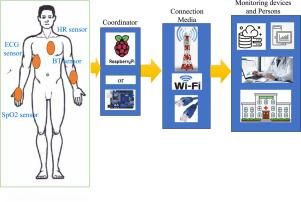SWAST KHOJ: An IoT-driven real-time health monitoring system prototype
IF 7.6
3区 计算机科学
Q1 COMPUTER SCIENCE, INFORMATION SYSTEMS
引用次数: 0
Abstract
This study focuses on developing a health monitoring system prototype using the Internet of Medical Things (IoMT) to provide continuous and real-time tracking of vital signs. The advent of IoT-enabled healthcare equipment is drastically changing the landscape of healthcare infrastructure, facilitating seamless communication among diverse devices and platforms. In this context, the significance of smart health monitoring applications in IoT has led to the exploration of various IoT frameworks by researchers. In this work, we have deployed a Wireless Body Area Network (WBAN) architecture in real-time healthcare prototype using discrete heterogeneous sensor nodes. The purpose of this prototype is to collect vital signs, which include temperature, heart rate, peripheral oxygen saturation (SpO2), and electrocardiogram (ECG). A Graphical User Interface (GUI) is used to display the gathered data in accordance with the Modified Early Warning Score (MEWS) medical criteria also risk level classification using k-Nearest Neighbor algorithm (kNN) based trained model. Periodically, our prototype, called SWAST KHOJ, uploads the data together with the timestamp to a local server. Additionally, we evaluate the prototype’s Quality of Service (QoS) parameter in an interior setting using a variety of short-range communication techniques, such as Bluetooth, ZigBee, and Local Area Network (LAN) or wired connection. Our evaluation reveals end-to-end delays of 0.514 ms for wired communication, 0.62 ms for Wi-Fi, 0.417 ms for ZigBee, and 1.92 ms for Bluetooth. Notably, our method demonstrates lower end-to-end delays compared to previous studies. In addition, we test the prototype’s throughput with several connection protocols.

物联网驱动的实时健康监测系统原型
本研究的重点是利用医疗物联网(IoMT)开发一种健康监测系统原型,以提供连续和实时的生命体征跟踪。支持物联网的医疗保健设备的出现正在彻底改变医疗保健基础设施的格局,促进了不同设备和平台之间的无缝通信。在此背景下,智能健康监测在物联网中的应用意义促使研究人员探索各种物联网框架。在这项工作中,我们在使用离散异构传感器节点的实时医疗原型中部署了无线体域网络(WBAN)架构。这个原型的目的是收集生命体征,包括温度、心率、外周氧饱和度(SpO2)和心电图(ECG)。使用图形用户界面(GUI)显示收集到的数据,这些数据是根据修正早期预警评分(MEWS)医学标准以及基于k-最近邻算法(kNN)的训练模型进行风险等级分类的。我们的原型(称为SWAST KHOJ)会定期将数据与时间戳一起上传到本地服务器。此外,我们使用各种短距离通信技术(如蓝牙、ZigBee和局域网(LAN)或有线连接)在内部设置中评估原型的服务质量(QoS)参数。我们的评估显示,有线通信的端到端延迟为0.514 ms, Wi-Fi为0.62 ms, ZigBee为0.417 ms,蓝牙为1.92 ms。值得注意的是,与之前的研究相比,我们的方法显示了更低的端到端延迟。此外,我们用几种连接协议测试了原型的吞吐量。
本文章由计算机程序翻译,如有差异,请以英文原文为准。
求助全文
约1分钟内获得全文
求助全文
来源期刊

Internet of Things
Multiple-
CiteScore
3.60
自引率
5.10%
发文量
115
审稿时长
37 days
期刊介绍:
Internet of Things; Engineering Cyber Physical Human Systems is a comprehensive journal encouraging cross collaboration between researchers, engineers and practitioners in the field of IoT & Cyber Physical Human Systems. The journal offers a unique platform to exchange scientific information on the entire breadth of technology, science, and societal applications of the IoT.
The journal will place a high priority on timely publication, and provide a home for high quality.
Furthermore, IOT is interested in publishing topical Special Issues on any aspect of IOT.
 求助内容:
求助内容: 应助结果提醒方式:
应助结果提醒方式:


